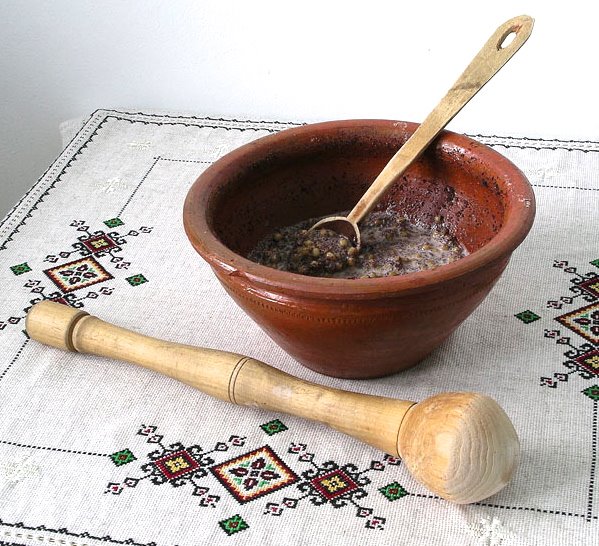Кутя
Kutia
Кутя
Kutia

About Kutia:
Our ancestors believed that kutia was the food of the gods (uzvar was the drink of the gods). It is an ancient food – Khvedir Vovk, the Ukrainian ethnographer, believed it came to us from the neolithic era. Its component parts – grain (wheat or barley), honey and poppy seeds – are foods that were eaten by our ancestors at the dawn of history, when agriculture was first being established.
Kutia was prepared three times, all on “Eves” – Sviat Vechir (January 6, the eve of Rizdvo), Shchedryi Vechir (the eve of the old New Year, January 13, also called Malanka), and on the eve of Yordan (January 19 was Vodokhreshchenia). They were known as Bahata kutia, Shchedra kutia, and Holodna kutia (rich, generous, and hungry kutia). There is a fourth variant of kutia, “Black” kutia, which was meant for the deceased. It was prepared for memorial services or funerals, and mixed with kolyvo. I don’t know much about this.
Kutia is one of the two “Mandatory” dishes for Sviat Vechir (uzvar being the other). A jar would be placed in the pokuttia, the “corner” of the house where the icons were kept, and should remain there until the old New Year. On Sviat Vechir children often took servings of kutia to their godparents (and sometimes other relatives).
The ritual character of the dish is emphasized by the old custom, in which the head of the family approached the window, or went out into the courtyard with the kutia and, turning to the frost , invited him three times to come in to dinner with his family. When frost does join them, he is advised not to appear, do not do evil to the crops, etc.: "Frost, frost, come eat kutia with us, but if you do not come, do not come to the rye, wheat and all the pashnytsia."
Kutia was served, usually first, and everyone shared. It was traditionally used to foretell a plentiful harvest and family happiness; a spoonful would be thrown at the ceiling – the more that stuck, the more bees and honey there would be. After dinner a portion was left on the table with everyone’s spoons stuck in it; this portion was for the souls of the deceased, and it was left overnight. If, in the morning, someone's spoon was found turned upside down, that person was supposed to die in the next year.
There is a rite associated with Yordan of "chasing away the kutia" and "shooting the frost". At midnight everyone went out of the house and into the courtyard with makahony, spoons, and sometimes other kitchen tools, beating them about the outside corners, fences or gates, and exclaiming:
Run kutia from our corner
And Uzvar - go to the bazaar,
But you, chickens, sit on eggs
Palanytsi remain on the shelves,
And Didukh - in a warm spirit,
Leave the kozhukh (coat)!
If at that time still there was still any kutia not yet consumed, it was given to the cattle.
The Food of the Gods
